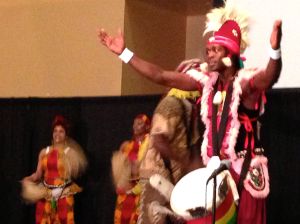New Orleans music fans have heard time and again about how, in the 1800s, the African rhythms of the slaves who gathered in Congo Square on Sunday afternoons combined with the European instrumentation of military marching bands to, eventually, create jazz.

Freddi Williams Evans signs copies of “Congo Square: African Roots in New Orleans” at Xavier University on March 11, 2013.
At Xavier University on Monday, the narrative went far deeper, discussing specific songs whose sounds linger in present-day second-line parades, highlighting the diverse contributions of various cohorts within the African influx, examining the evolution of traditional sounds in a modern context, and appreciating the dance moves that invite everyone to be part of the experience.
Dr. Michael White, a Xavier professor of Spanish and African-American music, was the host of “Congo Square: The African Roots of New Orleans Music.”
Freddi Williams Evans, director of education at the Contemporary Arts Center, presented some of the extensive research that went into her 2011 book, “Congo Square: African Roots in New Orleans.” She taught the audience to clap the rhythm of “Quan’ Patate La Cuite,” a Creole folk song with roots in Haiti, and then percussionist Luther Gray joined in to highlight the connections between that rhythm and the second-line beat.
Luther Gray and Bamboula 2000 performed modern interpretations of the traditional sounds, including “Bamboula Love Call” and a song based on the funga (or fanga) rhythm that segued seamlessly into “Lil Liza Jane.”
Djembe, World percussion instrument, Fanga rhythm performance by Rik Hambra from ricardo hambra on Vimeo.
Finally, Seguenon Kone and his troupe presented a storytelling performance of dance and music, relating the initiation of a simple hunter into the rhythms and traditions of the jegele, a type of balafon, or xylophone, played by the Senufo people of Mali and the Ivory Coast, where Kone is from.
I left the presentation excited about the beautiful things I have yet to learn about the rich history of New Orleans and her music.

loved your report! wished we had gone!